You can Download Chapter 11 Transport in Plants Questions and Answers, 1st PUC Biology Question Bank with Answers, Karnataka State Board Solutions help you to revise complete Syllabus and score more marks in your examinations.
Karnataka 1st PUC Biology Question Bank Chapter 11 Transport in Plants
1st PUC Biology Transport in Plants NCERT Text Book Questions and Answers
Question 1.
What are the factors affecting the rate of diffusion?
Answer:
Factors affecting the rate of diffusion
- Gradient of concentration
- Permeability of membrane
- Temperature
- Pressure.
Question 2.
What are porins? What role do they play in diffusion?
Answer:
The porins are proteins that form huge pores in the outer membranes of the plastids, mitochondria and some bacteria allowing molecules up to the size of small proteins to pass through. Thus porins facilitate diffusion.
Question 3.
Describe the role played by protein pumps during active transport in plants.
Answer:
Active transport uses energy to pump molecules against a concentration gradient. Active transport is carried out by membrane proteins. Hence different proteins in the membrane play a major role in both active as well as passive transport. Pumps are proteins that use energy to carry substances across the cell membrane.
These pumps can transport substances from a low concentration to a high concentration. Transport rate reaches a maximum when all the protein transporters are being used or are saturated. Like enzymes the carrier protein is very specific in what it carries across the membrane. These proteins are sensitive to inhibitors that react with protein side chains.
![]()
Question 4.
Explain why pure water has the maximum water potential.
Answer:
Water molecules possess kinetic energy. In liquid and gaseous form they are in random motion that is both rapid and constant. The greater the concentration of water in a system, the greater is its kinetic energy or water potential. Hence, it is obvious that pure water will have the greatest water potential.
Question 5.
Differentiate between the following:
(a) Diffusion and Osmosis
Answer:
Diffusion is a form of passive transport which takes place anywhere and the flow happens from high concentration to low concentration. Osmosis happens across a semipermeable membrane. For diffusion, the semi-permeable membrane is not a precondition.
(b) Transpiration and Evaporation
Answer:
Transpiration is the evaporation of water from the aerial parts of plants, especially leaves but also stems flowers and roots. Leaf surface are dotted with openings called stoma that are bordered by guard cells. Collectively these structures are called stomata. Leaf transpiration occurs through stomata and can be thought of as a necessary cost associated with the opening of the stomata to allow the diffusion of carbon dioxide gas from the air for photosynthesis. Transpiration also cools plants and enables mass flow of mineral nutrients and water from roots to shoots.
(c) Osmotic Pressure and Osmotic Potential
Answer:
The osmotic potential is defined as the capability of a solution to suck water in if it was separated from another solution by a semipermeable membrane. It is always a negative number. Higher the negative number of the osmotic potential of a solution, the more it will suck water in.
The terms isotonic, hypotonic and hypertonic describe the difference in osmotic pressure between the solutions with a certain osmotic potential. Two solutions are isotonic when the osmotic potentials are equal. When they are different, the one with the higher potential will have less pressure and the one with lower potential will have more pressure.
(d) Imbibition and Diffusion
Answer:
Imbibition is a special type of diffusion when water is absorbed by solids colloids causing them to enormously increase in volume. The classical examples of imbibition are absorption of water by seeds and dry wood.
Imbibition is also diffusion since water movement is along a concentration gradient, the seeds and other such materials have almost no water hence they absorb water easily. Water potential gradient between the absorbent and the liquid imbibed is essential for imbibition. In addition, for any substance to imbibe any liquid, affinity between the adsorbent and the liquid is also a prerequisite.
(e) Apoplast and Symplast pathways of movement of water in plants.
Answer:
Within a plant, the apoplast is the free diffusional space outside the plasma membrane. It is interrupted by the casparian strip in roots, air spaces between plant cells and the cuticula of the plant. Structurally the apoplast is formed by the continuum of cell walls of adjacent cells as well as the extracellular spaces, forming a tissue level compartment comparable to the symplast. The apoplastic route facilitates the transport of water and solutes across a tissue or organ. This process is known as apoplastic transport.
The symplast of a plant is the inner side of the plasma membrane in which water can freely diffuse. The plasmodesmata allow the direct flow of small molecules such as sugar, amino acids and ions between cells. Larger molecules, including transcription factors and plant viruses ! can also be transported through with the help of actin structures.
(f) Guttation and Transpiration.
Answer:
Guttation is the appearance of drops of vascular plants such as grasses. At night, transpiration usually does not occur because most plants have their stomata closed. When there is a high soil moisture level, water will enter plant roots, because water potential of roots is lower than soil solution. The water will accumulate in plant, creating a slight root pressure. The root pressure forces some water to exude through special leaf tip or edge structured called hydathodes forming drops. Root pressure provides the impetus for this flow. Transpiration, on the other hand, happens because of transpiration pull.
(e). Briefly describe water potential. What are the factors affecting it?
Answer:
Nater potential is the potential energy of water relative to pure free water in reference conditions. It quantifies the tendency of water to move from one area to another due to osmosis, gravity, mechanical pressure or matrix effects including surface tension. Water potential is measured in units of pressure and is commonly represented by the Greek letter 141’ (Psi).
![]()
Typically, pure water at standard temperature and pressure is defined as having a water potential of 0. The addition of solutes to water lowers its potential just as increase in pressure increases its potential. Seawater typically has negative water potentials relative to the pure water reference. If there is no restriction on flow, water molecules will proceed from the locus of pure water to the more negative water potential of the solution. Water potential of a cell is affected by both solute and pressure potential. The relationship between them is as follows
Ψw=ΨB +Ψp
Question 7.
What happens when a pressure greater than the atmospheric pressure is applied to pure water or a solution?
Answer:
If a pressure greater than atmospheric pressure is applied to pure water or a solution, its water potential increases.
Question 8.
(a) With the help of well-labelled diagrams, describe the process of plasmolysls in plants, giving appropriate examples.
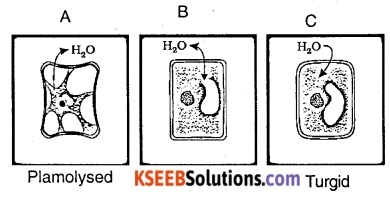
Plasnolysis occurs when water moves out of the cell and the cell membrane of a plant cell shrinks away from its cell wall. This occurs when the cell is placed in a solution that is hypertonic to the protoplasm. Water moves out, it is first lost from the cytoplasm and then from the vacuole. The water when drawn out of the cell through diffusion into the extracellular fluid causes the protoplast to shrink away from the walls. The cell is said to be plasmolyzed.
(b) Explain what will happen to a plant cell if it is kept in a solution having higher water potential.
Answer:
If a plant cell is placed in a hypotonic solution, the plant cell loses water and hence turgor pressure, making the plant cell flaccid. Plants with cells in this condition wilt. Further water loss causes plasmolysis-pressure decreases to the point where the protoplasm of the cell peels away from the cell wall leaving gaps between the cell wall and the membrane, Eventually cytorrhysis- the complete collapse of the cell wall can occur.
![]()
Question 9.
How is the mycorrhizal association helpful in absorption of water and minerals in plants?
Answer:
Some plants have additional structures associated with them that help in water and mineral absorption. A mycorrhiza is a symbiotic association of a fungus with a root system. The fungal filaments form a network around the young root or they penetrate the root cells.
The hyphae have a very large surface area that absorb mineral ions and water from the soil from a much larger volume of soil that perhaps a root cannot do. The fungus provides minerals and water to the roots, in turn, the roots provide sugars and Nitrogen-containing compounds to the mycorrhizae.
Question 10.
What role does root pressure play in water movement in plants?
Answer:
As various ions from the soil are actively transported into the vascular tissues of the ‘ roots, water flows and increases the pressure inside the xylem. This positive pressure is called root pressure and can be responsible for pushing up water to small heights in the stem.
Root pressure can only provide a modest push in the overall process of water transport. The greatest contribution is to re-establish the continuous chains of water molecules in the xylem which often break under the enormous tensions created by transpiration.
Question 11.
Describe transpiration pull model of water transport in plants. What are the factors influencing transpiration? How is it useful to plants?
Answer:
Transpiration is the evaporative loss of water by plants. It occurs mainly through the stomata in the leaves. Exchange of oxygen and carbon dioxide in the leaf also occurs through stomata. Normally stomata are open in the day time and close during the night. The cause is a change in the turgidity of the guard cells. The inner wall of each guard cell towards the stomatal aperture is thick and elastic. When turgidity increases, the thin outer walls bulge out and force the inner walls into a crescent shape. The opening of stoma is also aided due to the orientation of the microfibrils in the cell walls of the guard cells.
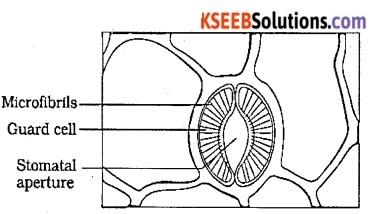
Factors affecting Transpiration: Temperature, light, humidity and wind speed. Importance of Transpiration: Transport of liquids and minerals is facilitated because of transpiration.
Question 12.
Discuss the factors responsible for ascent of xylem sap in plants.
Answer:
The transpiration driven ascent of xylem sap depends mainly on the following physical properties of water.
- Cohesion – mutual attraction between water molecules.
- Adhesion – an attraction of water molecules to polar surfaces.
- Surface Tension – water molecules are attracted to each other in the liquid phase more than to water in the gas phase.
Question 13.
What essential role does the root endodermis play during mineral absorption In plants?
Answer:
Unlike water, all minerals cannot be passively absorbed by the roots. Therefore most minerals must enter the root by active absorption into the cytoplasm of epidermal cells.
This needs energy in the form of ATP. The active uptake of ions is partly responsible for the water potential gradient in roots, and therefore for the uptake of water by osmosis. Some ions also move into the epidermal cells passively.
Specific proteins in the membranes of root hair cells actively pump ions from the soil into the cytoplasms of the epidermal cells. Transport proteins of endodermal cells are control points, where a plant adjusts the quantity and types of solutes that reach the xylem. It is important to note that the root endodermis because of the layer of suberin has the ability to actively transport ions in one direction only.
Question 14.
Explain why xylem transport is unidirectional and phloem transport bi-directional.
Answer:
Food, primarily sucrose, is transported by the vascular tissue phloem from a source to a sink. Usually, the source is understood to be that part of the plant which synthesizes the food and sink, the part that needs or stores the food. But, the source and sink may be reversed depending on the plant’s needs. Sugar stored in roots may be mobilised to become a source of food in the early spring when the buds of trees, act as sink; they need energy for growth and development of the photosynthetic apparatus. Since the source-sink relationship is variable, the direction of movement in the phloem can be bi-directional. This contrasts with that of the xylem where the movement is always unidirectional.
![]()
Question 15.
Explain pressure flow hypothesis of translocation of sugars in plants.
Answer:
The accepted mechanism used for the translocation of sugars from source to sink is called the pressure-flow hypothesis. As glucose is prepared at the source, it is converted to sucrose. The sugar is then moved in the form of sucrose into the companion cells and then into the living phloem sieve tube cells by active transport. This process of loading at the source produces a hypertonic condition in the phloem. Water in the adjacent xylem moves into the phloem by osmosis.
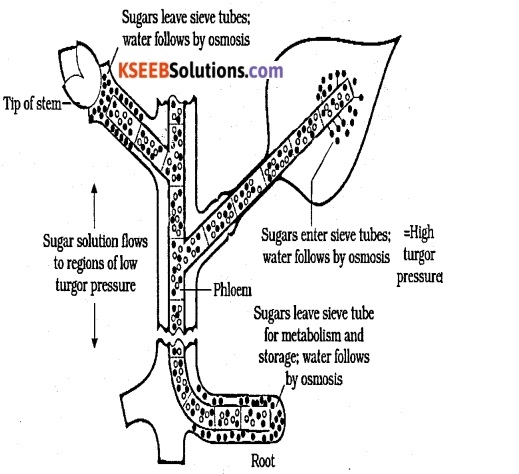
As osmotic pressure builds up the phloem sap will move to areas of lower pressure. At the sink osmotic pressure must be reduced. Again active transport is necessary to move the sucrose out of the phloem sap and into the cells which will use the sugar converting it into energy, starch, or cellulose. As sugars are removed, the osmotic pressure decreases and water moves out of the phloem.
Question 16.
What causes the opening and closing of guard cells of stomata during transpiration?
Answer:
Normally stomata are open in the day time and close during the night. The immediate
cause of the opening or closing of the stomata is a change in the turgidity of the guard cells. The inner wall of each guard cell, towards the pore is thick and elastic. When turgidity increases within the two guard cells flanking each stomatal aperture thin outer walls bulge out and force the inner walls into a crescent shape. The opening of the stoma is also aided due to the orientation of the microfibrils in the cell walls of the guard cells.
1st PUC Biology Transport in Plants Additional Questions and Answers
1st PUC Biology Transport in Plants One Mark Questions
Question 1.
What is Endosmosls? (Oct. 83, Apr. 84)
Answer:
When Water enters a living system the process is called endosmosis.
Question 2.
What is hypertonic solution? (Oct. 87, M.Q.P., Apr. 2000)
Answer:
The external solution which has a concentration higher than that of the cell sap is called Hypertonic solution.
Question 3.
What happens when fresh Grapes are put in sugar solution? (Apr. 90)
Answer:
Exosmosis
Question 4.
Define Plasmolysis? (April 1993, M.Q.P., Oct. 2000, 2003, July 2006, March 2010)
Answer:
Shrinking of Protoplasm due to exosmosis when cells are placed in a Hypertonic solution.
Question 5.
What happens to the plant cell when it is plasmolyzed? (Apr. 95)
Answer:
becomes flaccid
Question 6.
What is osmosis? (Oct. 97, Apr. 04)
Answer:
Osmosis is the movement of solvent from a region of higher concentration to lower concentration across a semipermeable membrane till equilibrium is attained.
Question 7.
Expand DPD (M.Q.P.)
Answer:
DPD. stands for Diffusion Pressure Deficit.
Question 8.
What is turgor pressure? (Apr. 98, 02, Oct. 04, July 2011)
Answer:
Turgor pressure is the hydrostatic presence developed in a cell due to the entry of water.
![]()
Question 9.
What is imbibition? (Oct. 98, March 09)
Answer:
Absorption of water by hydrophilic colloids.
Question 10.
What is water potential? (M.Q.P., Apr. 99, Oct. 02, July 07)
Answer:
Water potential is the difference between the free energy of water in a system and free energy of pure water.
Question 11.
What is the value of water potential of pure water at atmospheric pressure? (Apr. 05)
Answer:
Zero
Question 12.
Fresh grapes shrink in salt solution. Give reason. (July 2007)
Answer:
Fresh grapes shrink in salt solution because of exosmosis causing plasmolysis.
Question 13.
Give reason:
Excessive use of chemical fertilizers result in wilting of plants. (June 2009)
Answer:
Excessive use of fertilizers increases the solute Concentration of the soil solution causing exosmosis resulting in the wilting of plants.
Question 14.
Give reason:
Bacteria do not survive in highly salted pickles. (March 2010)
Answer:
Bacteria do not survive in highly salted pickles because they are plasmolyzed due to hypertonic nature of the salt.
Question 15.
Maximum absorption of water occurs In the origin of root hairs. Give reasons. (M.Q.P.)
Answer:
Root hairs provide enormous surface area for absorption. So maximum absorption . of water occurs in this region.
Question 16.
Who proposed pulsatory activity theory on ascent of sap? (Apr. 83, Oct. 2002)
Ans:
Sir. C. Bose
Question 17.
Which theory was proposed by Dixon and Jolly? (Oct. 94)
Answer:
Cohesion-tension theory
Question 18.
Define ascent of sap. (Oct. 2003)
Answer:
The upward movement of sap (mainly water) through the xylem from the base to the tip of the plant is called ascent of sap.
Question 19.
Give reason: Girdling experiment cannot be performed in sugarcane plants. (Apr. 07)
Answer:
An monocots the vascular bundles are scattered, girdling does not remove all the phloem. So girdling experiment is not performed in sugarcane.
Question 20.
Which instrument is used to measure the rate of transpiration? (Apr. 91,92,98, M.Q.P.)
Answer:
Photometer
Question 21.
What are antitranspirants? (March 2010)
Answer:
The substances which reduce the rate of transpiration in plants without affecting C02 fixation in photosynthesis or plant growth are called antitranspirants.
Question 22.
Give reason: (July 2008)
As the wind blows the rate of transpiration increases.
Answer:
As the wind blows the rate of transpiration increases because wind removes the saturated water vapours accumulated around the stomata during blowing and increases the rate of transpiration.
Question 23.
What is Epithem? (Apr. 04, July 2006)
Answer:
Loosely arranged parenchyma like cells present just beneath the air chamber of
hydathode are called Epithem.
Question 24.
Name the process by which H2O is lost as a liquid with the dissolved substances.
Answer:
Guttation. (Oct. 04)
Question 25.
In girdling experiment, the roots die first. (March 2011)
Answer:
In girdling experiment the roots die first because the passage of food is blocked.
1st PUC Biology Transport in Plants Two Marks Questions
Question 1.
Distinguish between endosmosis and ex-osmosis. (Apr. 85, Oct. 96, M.Q.P.)
Answer:
- Endosmosis is the movement of solvent molecules into the cell through selectively permeable membrane along a concentration gradient. Whereas, exosmosis is the movement of solvent molecules from the interior to outer medium through selectively permeable membrane along a concentration gradient.
- Cell becomes turgid due to endosmosis. Whereas, cell becomes flaccid due to exosmosis.
Question 2.
Differentiate between Turgid and Flaccid condition. (Apr. 87)
Answer:
- Turgid: A Turgid cell is one in which DPD = zero. The call has water to its maximum capacity and priasma membrane is extended right up to the cell wall.
- Flaccid: A Flaccid cell is one in which DPD = OP, the cell loses water and plasma membrane surrounds the shrunk protoplasm.
Question 3.
Define T.P. and DPD. What is the value of D.P.D. in a turgid cell? (Oct. 94)
Answer:
- T.P – Turgor Pressure: It is the hydro-static pressure developed when a cell is placed in hypertonic solution or pure water resulting in endosmosis.
- DPD – Diffusion Pressure Deficit: The quantitative decrease or deficit in diffusion pressure caused due to the addition of solutes is called DPD. In a turgid cell, DPD equals zero.
![]()
Question 4.
Write any two significances of diffusion in plants. (June 2009)
Answer:
The significance of diffusion in plants is
- To bring about gaseous exchange O2 and CO2.
- Transport of food material from one sieve-tube to the other.
Question 5.
Name any four physical theories of Ascent Of Sap. (Oct. 1993)
Answer:
Physical theories of Ascent of Sap.
- Atmospheric pressure theory
- Imbibitional theory
- Capillarity
- Root pressure theory.
Question 6.
Point but differences between Transpiration and Guttation. (M.Q.P.,April 96, 99, 03, 2006, Oct. 97, 2003)
Answer:
(1) Guttation
(a) Transpiration
(1) Water is lost in liquid form.
(a) Water is lost in vapour form.
(2) Loss of water takes place through hydathodes.
(b) Loss of water takes place through stomata
(3) Seen in some herbaceous plants only.
(c) Universal occurrence.
(4) Occurs only in the early morning time.
(d) Occurs when temperatures are high and bright light.
Question 7.
Mention any four environmental factors affecting transpiration.
(Oct. 01, April 05, July 2006)
Answer:
The four environmental factors affecting transpiration are light intensity, temperature, wind velocity and humidity.
Question 8.
Write the differences between transpiration and Evaporation. (March 2011)
Answer:
Transpiration
- It is a physiological phenomenon.
- It is controlled process
- It takes place through the surface of leaves, young stem, etc.
- Amount of water transpired is less.
Evaporation
- It is a simple physical phenomenon.
- It is not controlled.
- It takes place through the surface of various open water bodies and does not require the living organs or plants.
- The amount of water evaporated is more.
Question 9.
What is stomatal frequency?
Answer:
The number of stomata per square centimeter area of leaf is called stomatal frequency.
Question 10.
Write any four significances of transpiration. (March 2010)
Answer:
The significance of transpiration are
- Increase the rate of water and mineral absorption.
- Reduces leaf temperature resulting in cooling effect.
- Water is circulated within the plant body and maintains cell turgidity.
- Promotes the development of mechanical tissues.
Question 11.
Draw a labelled sketch of Hydathode. (Apr. 99,2001)
Answer:
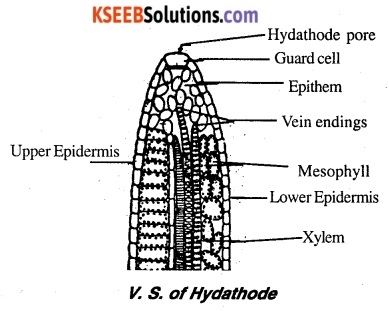
Question 12.
Discuss any three environmental factors affecting transpiration. (July 2007)
Answer:
- Wind: When the wind velocity is high the rate of transpiration increases.
- Humidity: higher the humidity the rate of transpiration decreases i.e. transpiration increases on a sunny day and decreases on a cloudy day.
- Temperature: higher the temperature greater is the rate of transpiration.
Question 13.
Define translocation and Ascent of Sap (April 1991)
Answer:
Movement of organic solutes or photosynthates from one part of the plant to the other is called Translocation. Ascent of Sap: Upward movement of Sap from the base to the tip of the plant is called Ascent of Sap.
Question 14.
Mention any 2 theories on mechanisms of Phloem conduction. (Oct. 1994)
Answer:
The theories put forth to explain Phloem conduction are
- Transcellular streaming
- Munch hypothesis
1st PUC Biology Transport in Plants Three Marks Questions
Question 1.
When any dry plant material or seeds are kept in water, the swell up name and define the phenomenon involved in this change. Describe the two conditions necessary for the phenomenon to occur.
Answer:
Imbibition is the phenomenon involved. It is a type of diffusion of water along a gradient into an adsorbent the two conditions are
- There must exist a water potential gradient between the surface of the adsorbent and the liquid imbibed.
- The affinity between the adsorbent and the liquid imbibed.
Question 2.
What is root pressure? How is it demonstrated experimentally?
Answer:
Root pressure is defined as the positive hydrostatic pressure developed in the root cortical cells, which pushes water into xylem upto a certain height. Root pressure can be demonstrated in the following ways:
- Choose a well-watered soft-stemmed plant
- Cut the stem horizontally near the base with sharp blade.
- Drops of fluid ooze out of the cut stem indicates a positive hydrostatic pressure, the root pressure.
- If the cut end is contracted to a rubber tube, the liquid can be collected and the rate of exudation measured.
Question 3.
Define diffusion. Is it active or passive? Why is diffusion important to plants?
Answer:
Diffusion is defined as the random movement of ions or molecules of any substance from the region of higher concentration to a region of lower concentration until equilibrium is attained. It is a passive process.
Importance to plants:
- It is the only means of gaseous exchange within the plant body.
- During transpiration, water vapour moves out of the leaf surface by diffusion.
![]()
Question 4.
Define the following:
(i) isotonic
Answer:
The external solution is isotonic, if it balances the osmotic pressure of the cell i.e. it has the same solute concentration as the cytoplasm.
(ii) Hypotonic
Answer:
If the external solution is weaker than the cytoplasm, it is said to be hypotonic.
(iii) Hypertonic
Answer:
If the external solution is more concentrated than the cytoplasm, it is hypertonic.
Question 5.
Describe 3 properties of water responsible for transpiration driven ascent of sap.
Answer:
- Cohesion – mutual attraction between water molecules
- Adhesion – attraction between water molecules and lignocellulosic cell wall of tracheary elements of xylem.
- Surface tension – Water molecules are attracted to each other in liquid phase more than water in gaseous phase.
1st PUC Biology Transport in Plants Five Marks Questions
Question 1.
Explain imbibition with an example. (M.Q.P.)
Answer:
Imbibition is the absorption of water by hydrophilic colloids. Imbibition requires an affinity between the imbibant and substance imbibed. Hence seeds and wood imbibe water where as rubber imbibes ether. Imbibition also requires a difference in water potential of imbibant and substance imbibed. Imbibition results in a pressure called imbibitional pressure of high magnitude and is defined as “the potential maximum developed in the imbibant due to entry of water.” Example: Wooden doors and windows absorb moisture in monsoon.
Question 2.
Describe an experiment to demonstrate the ascent of sap.
Answer:
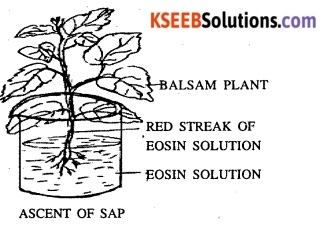
Aim:
To demonstrate ascent of sap using a Balsam or Peperomia plant
Procedure:
A rooted Balsam or Peperomia plant is placed in Eosin solution taken in a beaker and left aside under bright sunlight. After a few hours a section of the stem is taken and viewed under the microscope without staining.
Result:
A red streak can be seen through the transparent stem. The Xylem of the stem T.S. is coloured red.
Inference:
Because of transpiration pull the water (eosin solution) rises into the root, through the stem leaves and because of the transparent stem Xylem appears red. The path taken is through Xylem proved by viewing the section without staining.
Question 3.
Explain the cohesion tension theory; and mention its merits and demerits.
OR
Explain the transpiration pull theory of Ascent of Sap. Write Its one merit and demerit. (April 2006,2009, June 2009)
Answer:
This theory was proposed by Dixon and Jolly (1894). It is most important and widely accepted physical theory. This theory is based on the following features,
(1) Cohesion and adhesion:
The water molecules remain attracted by a force called cohesion. The force by which water molecules remain adherel to the lateral wall of trachea and trancheids of xylem is called adhesion. The cohesive and adhesive properties of water form an unbroken continuous water column in xylem. Such water column is continuous from roots to the leaves.
(2) Transpiration pull or tension:
Transpiration pull is a force created due to transpiration. OR a negative force or tension or it is pull created as a result of transpiration which is transmitted down to the root. As transpiration occurs, mesophyll cells of leaf loose water in the form of water vapour. Due to the loss of water vapours, the cytoplasm of mesophyll cells becomes concentrated and its osmotic concentration ( OC ) osmotic pressure ( OP ) and DPD are increased so they absorb water from the adjacent cells.
This process continues (evaporation absorption of water from the adjacent cells evaporation) upto the xylem vessels of leaf, then to the xylem vessels of petiole, stem and root. In other words, this tension is transmitted all the way down to the unbroken column of water through the stem to the absorbing parts or the root. So entire water column is pulled up.
Merits of transpiration pull theory:
(1) The force created by transpiration pull and cohesion is known to be capable of lifting the water column even to a height of 2000 m.
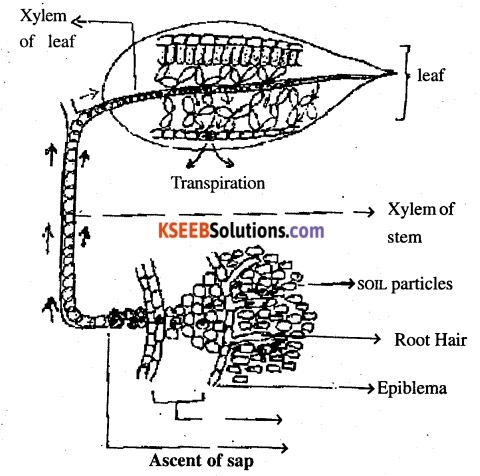
(2) The cohesive force of water is up to 350 atmospheres. The transpiration force created at the region of leaf is only 20 -50 atmospheres. It falls on the continuous water column but column does not break because the cohesive force of 350 atm can overcome this.
Question 4.
Explain stomatal apparatus with a neat labelled diagram and mechanism of opening and closing of stomata. (Apr. 84, 87, 95, 2005, Oct. 98, M.Q.P.)
Answer:
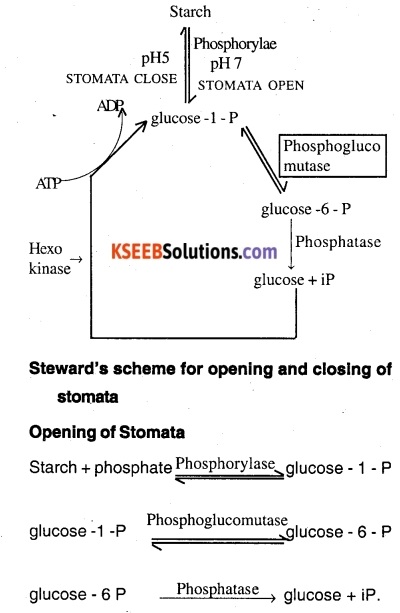
Stomatal IT movement has been explained by two important theories starch hydrolysis theory and proton transport concept.
Starch Hydrolysis Theory: This theory was proposed by Lloyd and elaborated by Scarth. It is also called Starch Sugar interconversion. It is based on the interconversion of Starch and sugar and effect of PH on enzymes.
Starch + P→ (Glucose-1-phosphate) n
During the day CO2 is used in photosynthesis, concentration is low in guard cells, as a result, the pH rises to 7.0. Enzyme is activated and starch is hydrolysed to glucose phosphate. This causes endosmosis which brings about turgidity and the guard cells open.
During night CO2 accumulates in guard cells and is converted to carbonic acid, PH decreases to 5.0 and causes the conversion of sugar to starch. Since it is insoluble water diffuses out causing exosmosis, guard cells are flaccid and the guard cells close.
This theory has the following drawbacks
- Photosynthesis in guard cells is too slow to bring about Osmotic changes.
- Malic acid accumulates in place of sugars.
- Enzymes does not catalyse the reverse reaction.
Proton Transport or Active potassium mechanism:
This theory was explained by Levitt. Guard cells in presence of sunlight use C02 during photosynthesis. With decrease in CO2 concentration, PH rises causing conversion of starch to sugar and finally, Malic acid is accumulated. This dissociates into H+ and Malate ions and by using ATP exchange H+ for K+ to form Potassium malate. The water potential becomes more negative causing endosmosis and the guard cells become turgid and stomata open.
During the dark Photosynthesis decreases, CO2 concentration increases and PH decreases to 5.0. K+ flows and again Malic acid accumulates. Flaccidity occurs as a result of exosmosis making the guard cells close. Closing is also influenced by ABA and Ca+2 ions.
![]()
Question 5.
‘Transpiration is necessary evil’ Discuss. (Oct. 86, 92, Apr. 91, 93, M.Q.P.)
Answer:
Transpiration is regarded as a ‘necessary evil’ because it has both advantages and
disadvantages.
Advantages:
- lncreases rate of water absorption and mineral absorption.
- lncrease the rate of transport within the plant body.
- Reduces leaf temperature resulting in a cooling effect.
- Water is circulated within the plant body and thereby maintains cell turgidity.
- Promotes the development of mechanical tissues.
Disadvantages:
- lf transpiration exceeds rate of absorption it results in death due to wilting.
- In rapid transpiration, turgor is lost and general metabolism is affected.
- It unnecessarily uses energy and creates, water shortage which causes death by desiccation.
Unavoidable: As long as Stomata are open the process continues.
Question 6.
Explain Steward’s starch glucose interconversion theory. (April 2007, March 2010, July 2010)
Answer:
(1) Starch hydrolysis theory:
(Starch – glucose inter conversion theory). This theory was proposed by steward (1964). It is modified theory of starch – sugar interconversion theory.
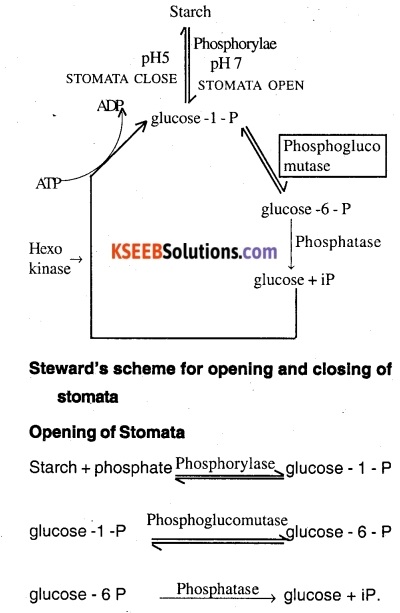
According to this theory following changes bring the opening of stomata.
- During day time, guard cells consume (use) CO2 for photosynthesis. So CO2 concentration decreases in the guard cells. pH of guard cells rises to almost 7.
- Under low CO2 concentration and at pH7, starch is hydrolysed into glucose -1 – P
( glucose -1 -phosphate) in the presence of phosphorylase enzyme. - Glucose -1 – P is convented into glucose -6 – phosphate in the presence of
phospho glucomutase. - Glucose -6 – P is finally converted into glucose is the presence of phosphatase.
- When starch is hydrolysed, glucose formed in the guard cells. Since glucose is osmotically active, Osmotic Concentration & Osmotic Pressure of guard cells increases &yw decreases.
- Water is drawn into the guard cells from the surrounding subsidiary cells.
- Guard cells become turgid due to endosmosis. So turgor pressure is developed in the guard cells. The TP exert a pressure on the outer thin elastic wall of guard cell, resulting in stretching of outer wall. The inner thick wall also stretched outward. It results in the opening of stomata.

Following changes bring closing of stomata.
- During night, in the absence of photosynthesis, CO2 accumulates in guard cells. Its concentration increases in guard cells. pH of guard cells decreases and it becomes 5(acidic).
- Under high CO2 concentration and at pH5, glucose is convented into glucose
-1 – phosphate in the presence of hexokinase. - Glucose -1 – phosphate is further converted into starch in the presence of phosphorylase.
- Starch formed in guard cells, which is insoluble and osmotically enactive. So OC and OP of guard cells decreases, ψ ω of cell sap of guard cells is increased.
- Water from the guard cells diffuse out into the subsidiary cells due to exosmosis.
- Guard cells become flaccid, outward stretched walls regain their original position and stomata become closed.
Question 7.
Explain the structure of hydathode with a labelled sketch.
Answer:
- T.P – Turgor Pressure: It is the hydro-static pressure developed when a cell is placed in hypertonic solution or pure water resulting in endosmosis.
- DPD – Diffusion Pressure Deficit: The quantitative decrease or deficit in diffusion pressure caused due to the addition of solutes is called DPD. In a turgid cell, DPD equals zero.
The hydathodes are present at the tips of the veins It consists of pore in the epidermis and it is guarded by guard cells. Just below the pore there is an air chamber. Just below the air chamber there is a group of loosely arranged thin walled, colourless cells (parenchyma like cells) are called epithem (Epithem are loosely arranged thin walled parenchyma cells present just below the air chamber of hydathode). Tracheids of xylem open just below the epithem. They are the ends of the xylem tissue of the veins.
Question 8.
Give any 5 differences between transpiration and guttation.
Answer:
Differences between transpiration and guttation.
Transpiration
- In transpiration water is lost in the form of water vapour.
- Transpired water is pure
- Transpiration takes place through stomata, cuticle and lenticel.
- It takes place during day hours.
- It is controlled by opening & closing by stomata (Stomatal mechanism).
Guttation
- In guttation, water is lost in the form of liquid droplets.
- The liquid coming out in guttation is not pure but it contains a number of dissolved substances like minerals, salts, sugar etc.
- Guttation takes place through hydathode.
- It takes place during the night or in the early morning.
- It is not controlled since hydathodes always remain open.
Question 9.
Define translocation of organic solutes.
Explain Munch’s hypothesis. Write its one merit and one demerit (Oct. 99, July 2011)
Answer:
Movement of organic solutes or photo synthates from one part of the plant to the
other is called translocation.
Munch used a model system to explain the translocation of solutes. Two Osmometers A and B were taken. ‘A’ filled with concentrated sugar solution and ‘B’ with dilute sugar solution. The Osmometers are made of semipermeable membranes. These are connected by means of a double bent tube ‘C’ containing water. The entire system is left in a trough D containing water. Water enters the osmometer A because of osmosis resulting in mass flow from A to C and finally B. The water from B is forced out because of pressure created due to mass flow.
This working model is comparable to the actual process occurring in plants, a pressure gradient exists between the source (comparable to A) where sugar is loaded (leaves) using ATP and the sink (comparable to B) where sugar is unloaded (storage organs). In the leaves, sugar enters the sieve tubes from companion cells which lower the water potential which pushes the sugar solution through the sieve tube-like water being pushed through a hose. At the sink, sugar is actively unloaded with the use of ATP, which increases the water potential and water moves out.
This, however, is the accepted model of phloem transport.
The theory fails to explain
- Bidirectional flow of organic substances.
- The role played by phloem.
- The resistance offered by plasmodesmata and sieve plates.
- It regards the process as purely physical
merits
- Supply end always has a high sugar level
- Turgor decreases in defoliated plants.
Question 10.
Explain Munch Hypothesis. (April 85, 88, 90, 2001, Oct. 1997, M.Q.P., July 2008)
Arts:
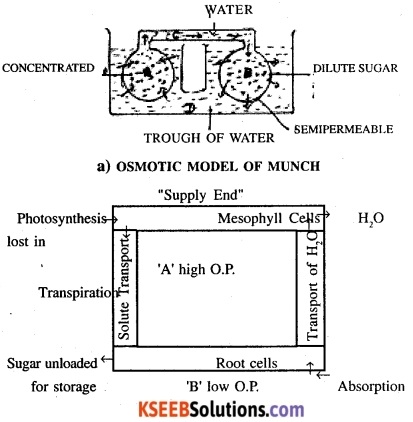
(b) Comparison of Munch Hypothesis in Plants
Answer:
Munch used a model system to explain the translocation of solutes. Two Osmometers A and B were taken. ‘A’ filled with concentrated sugar solution and ‘B’ with dilute sugar solution. The Osmometers are made of semipermeable membranes. These are connected by means of a double bent tube ‘C’ containing water. The entire system is left in a trough D containing water. Water enters the osmometer A because of osmosis resulting in mass flow from A to C and finally B. The water from B is forced out because of pressure created due to mass flow.
This working model is comparable to the actual process occurring in plants, a pressure gradient exists between the source (comparable to A) where sugar is loaded (leaves) using ATP and the sink (comparable to B) where sugar is unloaded (storage organs). In the leaves, sugar enters the sieve tubes from companion cells which lower the water potential which pushes the sugar solution through the sieve tube-like water being pushed through a hose. At the sink, sugar is actively unloaded with the use of ATP, which increases the water potential and water moves out.
This, however, is the accepted model of phloem transport.
The theory fails to explain
- Bidirectional flow of organic substances.
- The role played by phloem.
- The resistance offered by plasmodesmata and sieve plates.
- It regards the process as purely physical